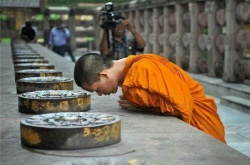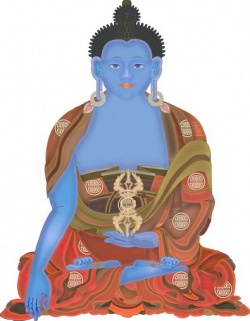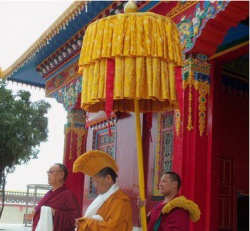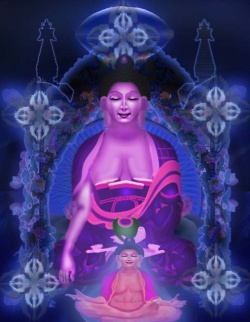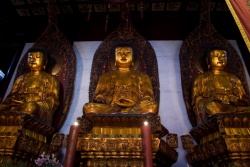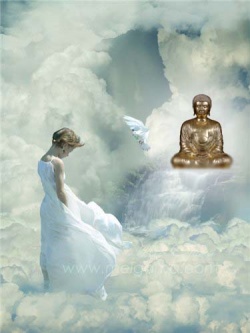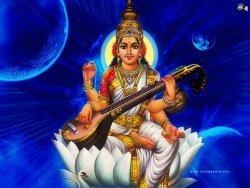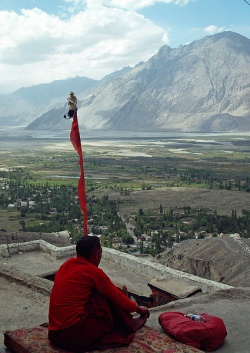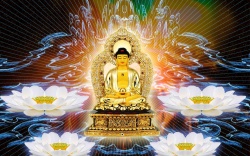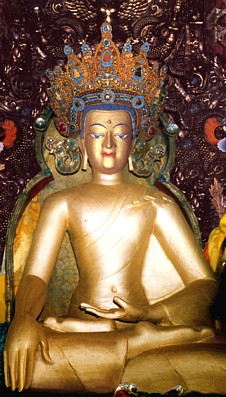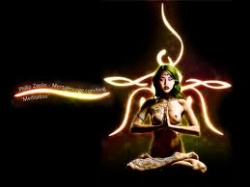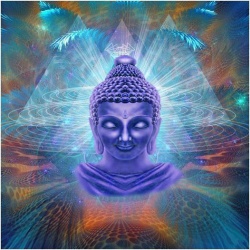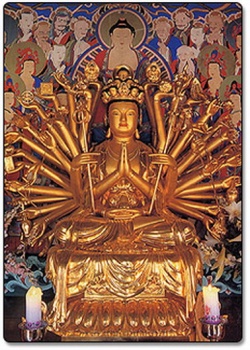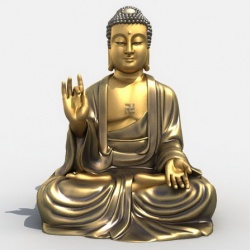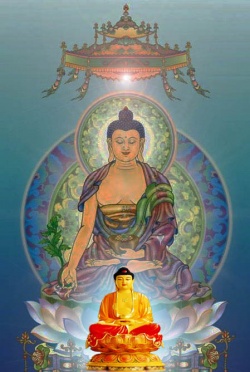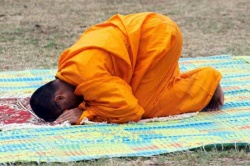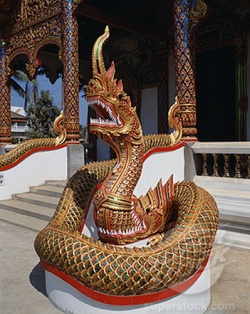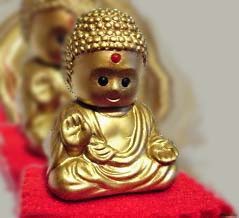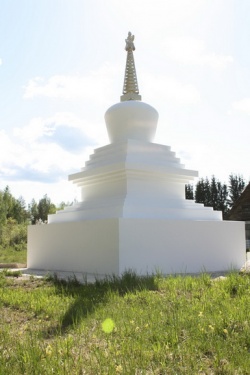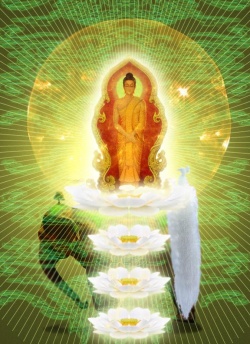Distinguishing the Vehicles of Therevada, Mahayana, and Vajrayana Buddhism
This post will be largely an attempt to explain, in forms accessible to Western ears, the primary differences between the main branches of Buddhism.
This will be done largely to help situate the reading of Tibetan Buddhism provided in my two most recent posts.
The Three Vehicles:
Theravada,
Mahayana, and
Vajrayana
Those who study Buddhism in its historical context quickly come to learn that there are three primary branches of Buddhism, the three vehicles,” which often go by the name
These developed in chronological order, first Theravada, then Mayahana, then Vajrayana.
Today Mahayana is the most widely accepted form, with the most practitioners. Theravada Buddhism, largely confined to contemporary Sri Lanka and South-East Asia, is a somewhat smaller branch in terms of numbers of adherents, even though it claims it has deviated the least from the original teachings of the Buddha himself (a claim which has been contested, for more on this, see Kate Crosby’s excellent book Theravada Buddhism).
Because it seems likely that there are differences between contemporary Theravada and the earliest forms of Buddhism, many scholars today differentiate these, referring to early Buddhism by this term, or sometimes using the term Nikaya Buddhism (a Nikaya is a grouping, such as an ordination lineage, or grouping of texts such as sutras).
While Therevada claims great similarity to early Buddhism, there are differences, and in many senses, the series of “reforms” which occurred throughout the history of Theravada (such as Buddhaghosa’s formation of an organized canon for scriptures during the 5th century CE in Sri Lanka, or various reforms made in the 17th and 18th century in places such as Burma and Thailand) are often seen by scholars as having given rise to contemporary Theravada as much as reforming it, particularly in regard to negotiating the relation between the most conservative form of Buddhism and its past,
and how this relation to the past intertwined with local traditions and practices on the ground. Mahayana Buddhism,
and Vajrayana Buddhism which grew from it, has a more flexible relation to the past, and particularly the past teaching of the historical Buddha Siddhartha Gotama, in that they see this as only one aspect of the revelation of Buddhist truths, allowing for greater flexibility in regard to negotiating with the past in regard to everyday practices.
In all it’s forms, however, it is important to note Buddhism has blended with a variety of religious practices that were there before it arrived, and with which it continues to have a relation. Buddhism found many ways to cohabitate with the worship of various deities,
often so long as these were seen as less perfect spirits and beings than the Buddha (or in the later Mahayana tradition, the many Buddhas and high level Bodhisattvas), and equally in need of liberation as less powerful beings such as humans.
This lead to a great amount of mutation and local variation, and this is why the practices of all contemporary forms of Buddhism are full of rituals and practices that are likely quite different from early Buddhism,
no matter how conservatively the scriptures are interpreted. In Theravada Buddhism, generally the most conservative form, local deities are usually kept outside of Buddhist practice,
even if in reality many temples, particularly outside of larger cities, may be shared between Buddhist and local practices, or be right next to each other on the same grounds, with many practitioners making use of both traditions for various needs.
In the Mahayana tradition there is the notion of “skillful means,” whereby things which can lead one to enlightenment can be brought into Buddhism even if they were not originally there, and so,
Mahayana Buddhism has tended to absorb local traditions into it more than the Theravada, seen most explicitly with the Vajrayana integration of many local deities for ultimately Buddhist purposes.
Beyond this, it is also difficult to try to base any contemporary Buddhist practice on what early Buddhism was like since it is in many senses nearly impossible to know this with any certainty.
Buddhism started an oral culture, with many of the scriptures not being committed to writing until around 500 years after the death of the historical Buddha,
and many of the earliest written scriptures not organized and standardized until about another 500 years after that.
Since most manuscripts were written on palm leaves, which disintegrate after around 200 years, there was a constant need to recopy scriptures, allowing for more potential variation.
While there were councils which supposedly standardized the oral story early during the history of Buddhism, many scholars feel the first two were likely legendary, with the first one that many scholars agree occurred having happened by around 300 years after the death of the Buddha.
And so, there is a great deal of reconstruction in likely any attempt to base contemporary practice on early forms which may have shifted greatly since ancient times yet leaving few reliable traces for potential comparison (for more, on these issues, see Crosby, above, and Donald Mitchell’s Buddhism: Introducing the Buddhist Experience).
While there were many small shifts within early Buddhist practices, the development of Mahayana Buddhism is the first truly dramatic shift within Buddhist orthodoxy.
Today Mahayana Buddhism has many branches, and is dominant in China, India, and Japan.
While Buddhism is largely a minor practice in India, many of its ideas seem to have blended with aspects of the forerunners of Hinduism in a relation of mutal influence in India during the premodern period.
Scholars disagree as to the origins of the Mahayana, though it seems that the Mahayana likely arose with the addition of new Buddhist scriptures,
some of which were said to be discovered in caves, revealed in dreams or visions, or handed down secretly through the ages to only be disclosed until the right time.
With the influx of new scriptures from seemingly diverse corners of the Buddhist world in India, starting to reach a critical mass around 0 CE, monks in Indian monasteries seem to have been divided on whether to accept the new scriptures,
until there was a gradual and then more pronounced split between those who accepted the new scriptures, who called themselves the Mahayana (or “great vehicle”) and those who only believed in the older scriptures, the Theravada (or “the way of the Elders”).
The new scriptures were more accessible, and found favor with the majority in India, particularly in the North, and it is Mahayana Buddhism in this form which was exported to China, where it eventually gave rise to Cha’an Buddhism (exported to Japan and renamed Zen), and from there to Japan and Korea.
While Mahayana Buddhists often refer to Therevada Buddhism as Hinayana Buddhism, or the “minor vehicle,” a term which views this more traditional set of practices as less complete understandings of the Buddha’s teachings, this is generally seen as a less than complimentary term, particularly by non-Mahayana.
While Mahayana Buddhism flourished in the North, Theravada found its heartland in the south of India, and particularly in the island of Sri Lanka, and from these south Indian strongholds Buddhism then spread to contemporary Thailand, Myanmar, Laos, and Cambodia where it thrives today.
Distinct from Theravada, and a distinct sub-branch of Mahayana, is the Vajrayana branch, which is dominant in Tibet, Mongolia, and parts of contemporary India and Nepal which are in frequent contact with the Tibetan world.
While Theravada Buddhists see the Mahayana as having strayed into some heterodox teachings from scriptures not derived from the original speech of the Buddha, and Mahayana Buddhist see themselves as having both the teachings of the earthly Buddha and the deeper and fuller teachings which come from the heavenly Buddhas
and Bodhisattvas as well, Vajrayana Buddhism is a continuation of the Mahayana trend to grow Buddhism into newer forms which are seen as deeper and fuller by its adherents.
Vajrayana Buddhism derives from the last stage of Indian Buddhism before its decline, a period after Mahayana was exported to China and had already established itself there.
Vajrayana was a product of the breakdown of the Gupta dynasty in India, a period of social chaos and warfare, in which a variety of magical practices were often deployed by mystics in the forests, and later, for the courts of the kings, often to help in warfare.
Vajrayana Buddhism, spurred by the Mahayana doctrine of “skillful means,” saw these practices as potentially quite powerful tools to help achieve Enlightenment, and so many of these techniques were altered and integrated into Buddhist teachings,
blended with Buddhist philosophy, and gave rise to a series of new techniques which were seen nevertheless as the older ideas in simply different forms.
Many of the new practices and texts were seen as revealed in a manner similar to the Mahayana scriptures, or were seen as passed down in secret from earlier times, only to be more directly taught when the world was ready to hear them.
While the from a Western, linear conception of time it may seem strange that the newer teachings were seen as deeper and even potentially older, since the teachings were felt to originate in a timeless time beyond time and place,
a time from which the cyclical time of rebirth itself emerges, these notions are much less unusual in their original cultural context.
Mahayana: Compassion, the Bodhisattva, and the Philosophy of Emptiness
What are the doctrinal differences between these? Most students of religion see the advent of the Boddhisattva in Mahayana scriptures as one of the primary shifts between the Theravada and Mahayana traditions, but there’s more to it than just that.
With the advent of Mahayana, the notion of compassion comes to the fore in Buddhist thought, and the Boddhisattva is the embodiment of this.
The word Mahayana, which means “greater” vehicle can also be understood as “more encompassing” vehicle, and in this sense it is the Buddhist path that opened Buddhism beyond the monasteries and gave it a wide popular appeal.
Mahayana scriptures spoke frequently about non-monastics as being able to achieve spiritual heights, indicating that it was not necessary to be a monk or nun to gain enlightenment.
Beyond this newfound path for the laity, Mahayana scriptures emphasize compassion, with the Bodhisattva as the new spiritual goal which embodies this, for the Bodhisattva is conceived as a being of compassion who delays full Buddha-hood to remain in this world and teach to relieve the suffering of other beings.
Furthermore, Mahayana Buddhism argued that it was impossible to achieve enlightenment without compassion, for if enlightenment means selflessness, a notion present since the earliest strata of Buddhist teachings,
then for the Mahayana true enlightenment must be seeing others as oneself, deconstructing the self-other binary and providing a doctrinal support for the prioritizing of compassion.
According to this approach, if there’s suffering in the world, I only see that suffering as not mine if I have a discrete notion of the self.
But since Buddhist practice aims to deconstruct the self, the suffering of others becomes my suffering as well if I have no-self, and hence my own enlightenment and compassion in regard to the suffering of others becomes necessarily intertwined.
In this sense, reducing the suffering of others reduces my own, because the more I am compassionate, the more the obstacle to my own enlightenment which is my self is reduced.
Furthermore, the more my self is reduced, the more I am able to see clearly, and hence, able to direct others onto the path, so the goal of helping self and others become aspects of the same.
While these notions are in some sense implicit in earlier Buddhist notions, Mahayana Buddhism makes them central to its approach to the world. There are other crucial shifts in emphasis, however, such as the notion of emptiness.
If the notion of no-self is central to early Buddhism, this is expanded in a Mahayana context to indicate not only the no-self of persons, but also of things, a notion described as emptiness.
First articulated in some of the early mystical Mahayana sutras, this notion was turned into an entire worldview by the greatest philosopher of the Mahayana, Nagarjuna.
While frequently misunderstood, emptiness is not the notion that there is nothing in the world, but rather, that anything we encounter is simply the manifestation of the influences, contexts, and processes which bring it about,
and in this sense, it is also the continuation and development of the early Buddhist notion of interconnectedness, or dependent origination.
From the perspective described by emptiness, everything is dependent upon its continual recreation within the processes that make up the world, and so, we should not distinguish out any particular aspect of the world as fully distinct, for this is a manifestation of and fosters our craving, namely, that which keeps us from enlightenment.
This is a development from the arguments originally applied within Buddhism to the deconstruction of the self.
When we examine our consciousness, we see that various sense impressions flow by, or thoughts or feelings. But which one of these is the self? The self seems to be the awareness of these things, a deeper type of entity.
But since the self can never grasp itself as an object, but only the objects and entities of which it is composed, it is in a sense an empty notion.
Likewise, any object in the world can be deconstructed to its parts, but remove all of these, and there is no there there, so to speak.
This is why many contemporary commentators have argued that Nagarjuna’s notion of emptiness can perhaps be best understood, in a western philosophical contexts, as essencelessness.
That is, there is no fixed essence which expresses itself in entities in our world.
Rather, there are interactions between parts, wholes, contexts, influences, processes, etc. But there aren’t transcendental essences that require that things stay the same, or only change in particular ways.
Rather, there is simply cause and effect, in infinite chains and networks as far as the eye can see.
Freedom is the realization that everything can change, doesn’t need to remain fixed to an essence, and in fact, the illusion of permanency is what keeps us trapped in limiting worldviews and habits, because we cling to and desire a permanency which is ultimately impossible.
Desiring a new car, for example, we fail to realize that really we are desiring the fact that others desire such a car, which is really desiring to be liked or respected by them, when really what we desire is to not feel empty, lonely, or incomplete, a problem which only occurs if we think there is a fullness out there we need to somehow acquire.
But when we see that things and persons are ultimately empty, we stop craving, and this cuts the cycle and all the habits to which it gives rise, and allows us to imagine moving beyond the cravings which keep us attached to the play of mirrors which is samsara, or cyclic existence, simply going around in circles without ever knowing any sort of deeper peace.
It is for these reasons that the Mahayana scriptures aregue that “nirvana is samsara.”
Rather than view nirvana, the extinguishment of suffering, as some other realm beyond the world of cyclic existence of everyday life,
rather than see nirvana as some other or transcendent state potentially beyond this world, notions dominant in early Buddhist and Theravada practices, Mahayana scriptures reframe nirvana as simply a different way of looking at samsara.
That is, nirvana is here and now, we just do not realize it. Rather than turn nirvana into a possible object of craving, it is rather viewed as what happens when we stop craving, including craving nirvana, leading to a cessation of suffering.
Rather than desire to simply leave the world, this new perspective merges with the goal of the Bodhisattva to stay here and work to decrease the suffering of all sentient beings.
If Buddhism was originally described by the Buddha as the “middle way” between asceticism and hedonism, this development is in many senses a new form of this, in that the binary between nirvana and samsara is deconstructed, made empty, and hence, nirvana is less likely to be craved, paradoxically making it more attainable.
Another development of the Mahayana is that nirvana is definitively described as being blissful.
While early Buddhism often says very little about nirvana, other than that it is beyond our experience and hence very little can be said about it other than that it is the extinguishment of the suffering of endless cycling in karmic samsara, Mahayana Buddhism makes clear that nirvana is a blissful experience.
Nevertheless, bliss is not seen as the same thing as happiness, which is fleeting. Bliss, on the other hand, is stable, a state in which one does not need anything because one is already satisfied.
In this sense, it is similar to the ways in which the gods are often described within Indian traditions, yet in sync with the notion that nirvana is beyond craving.
It should not be thought that craving is the same as desire in a Western sense, however.
It is fine in most Buddhist traditions to have good intentions, such as to achieve enlightenment, just not to crave this.
Intention is a term often used in Pali and Sanskrit (the term chanda) to describe a form of desire that is without craving (the term tanha, the source of suffering in Buddhist doctrine).
This distinction is a fine one and often leads to confusion when these notions are translated into English, in that both terms can be rendered as desire.
In English then it perhaps makes sense to say that desire only leads to suffering when it becomes craving, or that craving is desire gone wrong, when desire becomes obsession, addiction, fetishism, fixation, etc.
While it is often said in the West that Buddhism is against desire, the situation is much more complex than that.
Beyond mainstream Mahayana, Cha’an/Zen Buddhism is a branch of Mahayana Buddhism that is particularly influential today in Japan. Originally, it came about as an attempt to develop an more down-to-earth Buddhism, one which dispenses with complex arguments of academics or complex tantric rituals.
Cha’an/Zen, a term which is an attempt to translate one of the Sanskrit terms for meditation, dhyana, into Chinese, emphasizes meditation above all, whether in the form of sitting meditation, or other forms such as walking or doing physical labor.
Cha’an/Zen often views reason and overthinking as hindrances upon this path, and particularly in the Japanese traditions, make use of paradox to help shock students beyond traditional forms of conceptuality.
In many senses Cha’an/Zen are radically anti-academic, with many of its earliest teachers being illiterate, yet today Zen has a reputation in the West for being highly cerebral, precisely because it revels in paradoxes which seem to deconstruct reason with its own tools.
For all these reasons, it has fascinated the Western imagination, perhaps in a way that outstrips its influence within the wider Buddhist world.
The rationality of the irrational remains at its core, and it’s likely that the fascination of the West with this approach has to do with the West’s own emphasis upon particularly rigid forms of rationality.
It’s also worth noting that the Mayahana tradition, particularly as it moved to China and especially Japan, makes use of the term suchness (tathata or dharmata in Sanskrit, chen-ju in Chinese, and shenyo in Japanese.)
This is the flip-side of emptiness, or rather, the integration of emptiness and appearance. Suchness is often described as an attempt to see the world without preconceptions of the way it must be, similar to Freud’s notion of even-hovering attention.
It is continual curiosity about what the world in all its manifestations, down to the simplest physical experiences, can show us.
It is being with these, holding these, not needing them to be one way or another, but experiencing them in their full emptiness and empty fullness, which describes the notion of suchness.
While this term became influential relatively late in the development of the Mahayana, it became highly influential, particularly in Chinese and Japanese thought on Buddhism, even if, as with many Mahayana notions, it can be seen as developing notions implicit in the basic ideas articulated early in the tradition, such as no-self, interconnectedness, cessation of craving, etc.
Vajrayana: Tibetan Buddhism, and Virtual Reality
Vajrayana Buddhism, an offshoot of Mahayana Buddhism which in many ways became a distinct third branch, extends and radicalizes many aspects of the Mahayana Buddhism from which it developed, even if it transformed these with the integration of a variety of new tantric practices.
If Therevada largely concentrates on exploding the suffering/non-suffering binary, Mahayana the self/world binary, and Cha’an/Zen the reason/unreason binary, then Vajrayana focuses on the reality/fantasy binary.
Vajrayana sees itself as the completion of the other two “vehicles,” providing a vehicle which does not dispense with the world but rather makes use of it as a path to enlightenment.
According to Vajrayana Buddhists in Tibet and elsewhere, Theravada limits the Buddha’s message to the few, Mahayana opens it up to the many, but Vajrayana makes it possible to envision an entire Buddhist society.
The reason for this is that it is able to speak a language even more accessible than that of Mahayana, one which could not have been revealed earlier, however, because the world wasn’t ready for it.
Only after the advances of Mahayana, bringing Buddhism out of the monasteries and to the masses, was it possible to imagine constructing Vajrayana. As is to be expected, the other two branches view Tibetan Buddhism as a step away from Buddhist orthodoxy.
From the perspective of Mahayana and Therevada orthoxies, Vajrayana Buddhism goes much further than Therevada’s agnostic relation to local gods, and Mahayana’s attempt to incorporate them as being enlightened by the Buddha and having become his disciples.
For mainstream Buddhists in Theravada and Mahayana traditions today, Vajrayana is often seen as having absorbed too much of the Indian religions of the Indian medieval period and the local Tibetan religions.
Vajrayana Buddhism makes use of sets of practices which go beyond traditional Buddhist meditation, and employ intense and intricate visualizations of virtual worlds, practices aimed at transforming the body by meditation, and series of difficult rituals which have spiritual meanings yet go far beyond those in many other forms of Buddhism.
Tantric Buddhism sees every aspect of the world as having a potential role to play in producing a path to enlightenment, and hence, rather than leave the world behind, it is transformed into the path.
This even goes as far as seeing sex as having a yogic function which can help a person on the path to Buddhahood. But if Buddhism attempts to tame desire, how can this be possible?
As was mentioned earlier, the issue here is not so much desire but rather craving.
Building upon this, Vajrayana Buddhism sees two approaches to enlightenment, namely, sutrayana, or the approach of using written verses and traditional meditation, and tantrayana, or the use of special techniques, known as tantra, to speed the process up.
If sutrayana is seen as a path in which may take thousands of eons to attain enlightenment, tantrayana is seen as making enlightenment possible in one lifetime.
While Mahayana and Theravada practitioners may view this as unorthodox, Varjayana practitioners view this as the set of secret techniques that the Buddha could only reveal privately at first, or teachings which emerged in visions and dreams which could only be made public later, and even then only in full form to a select few.
Tantric techniques often start with ritual, then move to the internalization of this ritual and its expansion in visualization.
And anyone who has studied Tibetan Buddhism knows that its meditation exercises aren’t traditional forms of meditation, such as meditations upon an object, one’s breath, the notion of impermanence, or many of the other more traditional topics.
Rather, Varjayana meditation often involves the mental construction of intricate and brilliant visions of gods in refuge fields, in trees that spread multicolored light via dazzling jewels.
There is also the role of the mentor, the guru (Indian) or lama (Tibetan), who is seen as the embodiment of perfection, the means whereby the Buddha communicates to the initiate.
The mentor introduces the initiate slowly into meditating on a carefully prescribed set of visions, designed “like a ladder” to pull one deeper into enlightenment.
If all goes well, not only do the emptiness and bliss, or presence and absence, of things become indistinguishable, freeing up desire from craving.
Going beyond this, the visions themselves become more real to the initiate than everyday reality, liberating the practitioner from cravings related to the everyday world, by means of visions which, as practitioners are reminded frequently, arise and are decomposed back into luminous emptiness.
As the initiate comes to realize that all their experiences are empty, whether sensory or envisioned,
they increasingly come to see their envisioned dreams as having influence on their sensory embodied lives, and the everyday world becomes more and more like the virtual realities of these meditations.
It is for this reason that, in my previous post, I described Tibetan forms of Buddhism as a sort of virtual reality combat with “the real world” of sensory experience.
Tibetans know these visions aren’t real per se, at least, not like the sensory world, but the more real they seem, the more their approach to the sensory world shifts.
The sensory world is seen as deriving, in a sense, from the virtual world. This world isn’t elsewhere, it is here, and yet, indicates the potential for perfection within this world.
In this sense, these fantasies are a sort of immanent fantasy, an attempt to create a this worldly heaven which can alter the very way we live in this world.
And as initiates increasingly control their visions, they then begin to work to control ever more precise parts of their bodies with these visions. This is where physical yoga practices start to play a role.
And in all this, our own desires, our intentions often inmixed with cravings, are essential. If sutrayama is the path of the sutra, then tantrayana is the path of desire, and often in Tibetan literature these are described as the right hand path, and the left hand path, respectively, of the Buddha’s teachings.
Rather than dispense with desire, the left hand path makes use of it to shift it.
The desire for the mentor to embody perfection produces an intersubjective situation similar to psychoanalytic transference, in which the desire of both analyst and patient is actually the engine of the cure.
Likewise, the mentor relationship, in which the mentor’s imperfect self is seen as a conduit to the inner enlightened self of the practitioner to be that they are, provides the relational network between subjects which allows them to pull each other up the chain by their desires into mutual self-transformation.
Likewise, the visions are supposed to become self-fulfilling prophecies of a sort. Rather than feel defeated, one imagines oneself as a deity of enlightened qualities, if one that we can only partially recognize because we have layers of illusion that we are only learning to see through.
The more we visualize ourselves as identifying with a deity of enlightened qualities through the mentor, the more we desire to change ourselves to be liberated from worldly craving like that deity.
What we see here is not radically unlike a entire social form of what we practice individually in the western world as therapy.
In all of these Vajayana practices, the goal is for individuals to learn to separate from clinging to limiting self-conceptions, objects of desire, narratives of what one “should do” in the world, etc., and replace this with what is often called in Buddhist practice non-duality.
This is the state of interpenetration of opposites, a state of tensionless tension in which one is both presence and absence, nirvana and samsara, fullness and yet also emptiness.
Between self and world, reality and fantasy, all is possible but none is binding on the subject.
The goal is freedom to act in the world with less compulsion, for in the liberated world described in Buddhist visions, there is complete freedom from having to take any form, combined with the freedom of luminous emptiness to take many.
The Buddha, and the lesser gods which are his emanation, are seen as possible states that a Buddha can emanate once they have achieved pure enlightenment, which is pure freedom.
Once the initiate realizes the boundary between reality and fantasy is permeable, then decision precedes desire, and the desire for freedom becomes a sort of self-fulfilling prophecy.
Tibetan Buddhism is an attempt to give this a concrete form that the maximum number of people can latch onto, by means of visualizations, introductory rituals, and a wider Buddhist society structured around these notions.
A Fourth Vehicle? Social Activism and Buddhist Practice
While this might seem like an oversimplification of the Buddhist message, the use of colorful picture stories to water down Buddhism for the masses, the fact is that the visions, meditations, and bodily exercises are carefully constructed,
and always in relation to the mentor, in a way that the subject is guided to continually separate from any particular reified concept or binary dualism that would limit their approach to the world.
By keeping subjects identifying with that which is outside time, place, embodiment, and reality, the subject sees all before them as contingent.
They aren’t deluded that they can change physical reality, at least, not unless they learn the higher techniques of learning how to transmute fantasy into reality.
But as the tantric path gets to the higher rungs, the initiate is led back to the body, and even to sexual intercourse, if under rather controlled and ritualized circumstances.
And if we see this in the context of compassion, which is to say, the fact that it is impossible to achieve enlightenment without pointing the path out to the world, we see that the dream of a Buddhist society is in fact the very transformation that Tibet has tried to put into practice with its collective tantra.
The dream of individual liberation only comes about by means of a collective dreaming, which then feeds back into collective action.
The Utopian longing for a better life, one of true liberation, helps us detach from our mental cages.
But once we learn to dream freely, we then have to learn how to make reality like our dreams, to bring these notions to others, and teach by example.
This is not to say that Tibetan society actually achieved its goals of creating a truly Buddhist society.
In many ways Buddhist societies, Tibetan ones included, have a history of being incredibly hierarchical, and with incredibly unequal treatment of women and the poor.
Tibetan society before the Chinese invasion was a form of feudalistic theocracy which allowed no personal or collective freedom or dissent, and in this, it seems to me,
it misses many of the liberatory potentials of what Buddhism could be, and is out of sync with the relative democracy and equality of early Buddhist societies as described in the early Buddhist scriptures.
Within all this, there remains however, and in all forms of Buddhism, a certain emphasis on quietism and individual liberation over activism and collective liberation. Tibetan Buddhism, like all Buddhism,
is a prescription for finding release from the images, narratives, and concepts that trap us into thinking reality should be one way or another.
And in this it helps us free ourselves from needing the world to be a certain way to make us happy.
But in the end, there is a limit to what this can do without changing the world as well. Of course, the world must be ready for this change.
And this is why one needs to pursue one’s own enlightenment not only for oneself, but for the sake of others, and vice-versa. Because the more enlightened one becomes,
the more one will be a model that will inspire others to follow, in that, at least in theory, one will radiate bliss, and this will draw the desire of others to your path. In this way is it possible for the world to be transformed.
Nevertheless, without changing society as well, one liberated person meditating all day is likely to change very little of the world beyond themselves, and even though Buddhism, particularly in Vajrayana form, aims to dissolve the distinction between virtual and concrete, reality and fantasy, it often only does this within the individual mind.
Unless this is done collectively, it is likely very little of the world beyond the individual will change, and for a belief system which prizes the notion of no-self, this would seem to be an emphasis on the self which does not quite fit and is ultimately a major limitation.
And this is why I think it is even possible to imagine an activist Buddhism.
One that goes beyond Tibetan practice, to a new vehicle. A radically social vehicle.
The similarities between various forms of Buddhism and psychoanalysis are I think clear, but there are also potential parallels with Marxism as well.
For what is a social virtual reality experiment, a collective vision, if not the dream of the proletariat?
Source
[[1]]
